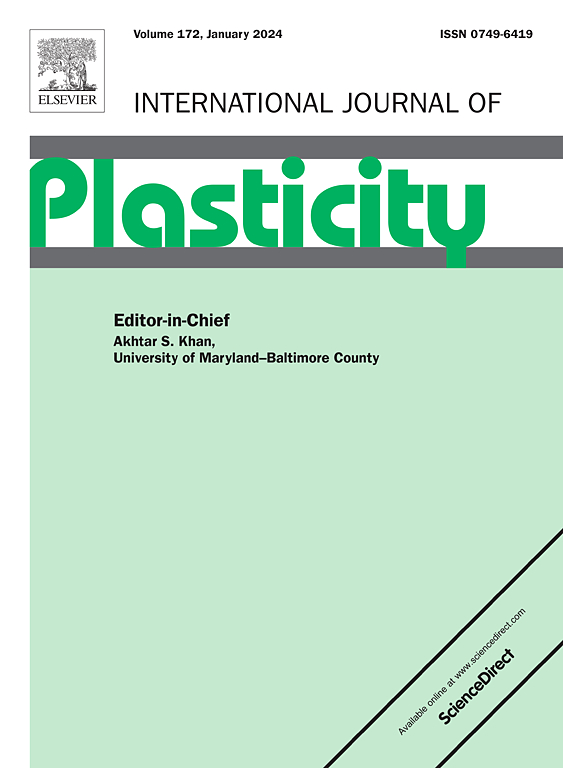高硅含量和非均质层状结构打破了亚稳态β21s合金的强度-延性平衡
IF 12.8
1区 材料科学
Q1 ENGINEERING, MECHANICAL
引用次数: 0
摘要
亚稳态β21S钛合金屈服强度不足、均匀伸长率受限,在实际应用中面临着很大的挑战。虽然硅的加入已被证明对提高钛合金的机械性能是有效的,但传统观念将硅的含量限制在≤0.5 wt.%,以避免由粗硅化物形成的脆化。本研究通过创新的合金设计挑战了这一范式,将0.9 wt.% Si结合等温处理和热挤压,创造了一种非均质层状结构(HLS) β21S-Si合金。我们的方法实现了双重微观结构控制:等温预处理诱导出约10 nm的纳米线硅化物前体,将最终沉淀细化到230 nm(传统工艺中为700 nm),而随后的挤压破坏了连续的晶界硅化物,并构建了一个明确的非均质片层结构,包括再结晶和亚结构片层。优化后的HLS β21S- si具有优异的力学性能,与基准β21S相比,其屈服强度为1035 MPa(提高10%),均匀伸长率为12%(提高8倍)。结合SEM-DIC和第一性原理计算的多尺度表征揭示了一种独特的顺序加工硬化机制:非均质变形诱导(HDI)硬化主导了早期阶段,随后是硅促进的交叉滑移活动,在后期变形期间达到应力诱导的ω相变。这种微结构工程变形机制的协同相互作用为克服亚稳β-钛合金的持久强度-延性权衡建立了新的途径,对要求高性能结构材料的航空航天应用具有重要意义。本文章由计算机程序翻译,如有差异,请以英文原文为准。

Breaking the strength-ductility trade-off in metastable β21s alloy via high silicon content and heterogeneous lamellar architecture
The metastable β21S titanium alloy faces significant challenges in practical applications due to its insufficient yield strength and restricted uniform elongation. While silicon addition has proven effective in enhancing mechanical properties of titanium alloys, conventional wisdom restricts Si content to ≤0.5 wt.% to avoid embrittlement from coarse silicide formation. This study challenges this paradigm through innovative alloy design, incorporating 0.9 wt.% Si combined with isothermal treatment and hot extrusion to create a heterogeneous lamellar structured (HLS) β21S-Si alloy. Our approach achieves dual microstructural control: isothermal pretreatment induces ∼10 nm nanowire silicide precursors that refine final precipitates to 230 nm (from 700 nm in conventional processing), while subsequent extrusion disrupts continuous grain boundary silicides and constructs a well-defined heterogeneous lamellar architecture comprising recrystallized and substructured lamellae. The optimized HLS β21S-Si exhibits remarkable mechanical performance, demonstrating a 1035 MPa yield strength (10% enhancement) and 12% uniform elongation (8 × improvement) compared to baseline β21S. Multiscale characterization combining SEM-DIC and first-principles calculations reveals a unique sequential work-hardening mechanism: heterogeneous deformation-induced (HDI) hardening dominates early stages, followed by silicon-promoted cross-slip activity, culminating in stress-induced ω phase transformation during advanced deformation. This synergistic interplay of microstructure-engineered deformation mechanisms establishes a new pathway for overcoming the persistent strength-ductility trade-off in metastable β-Ti alloys, with significant implications for aerospace applications demanding high-performance structural materials.
求助全文
通过发布文献求助,成功后即可免费获取论文全文。
去求助
来源期刊

International Journal of Plasticity
工程技术-材料科学:综合
CiteScore
15.30
自引率
26.50%
发文量
256
审稿时长
46 days
期刊介绍:
International Journal of Plasticity aims to present original research encompassing all facets of plastic deformation, damage, and fracture behavior in both isotropic and anisotropic solids. This includes exploring the thermodynamics of plasticity and fracture, continuum theory, and macroscopic as well as microscopic phenomena.
Topics of interest span the plastic behavior of single crystals and polycrystalline metals, ceramics, rocks, soils, composites, nanocrystalline and microelectronics materials, shape memory alloys, ferroelectric ceramics, thin films, and polymers. Additionally, the journal covers plasticity aspects of failure and fracture mechanics. Contributions involving significant experimental, numerical, or theoretical advancements that enhance the understanding of the plastic behavior of solids are particularly valued. Papers addressing the modeling of finite nonlinear elastic deformation, bearing similarities to the modeling of plastic deformation, are also welcomed.
 求助内容:
求助内容: 应助结果提醒方式:
应助结果提醒方式:


